Hackaday readers are well aware of the problems caused by materials left exposed to the environment over time, whether that be oxidized contact pads on circuit boards or plastics made brittle from long exposure to the sun’s UV rays.
Now consider the perils faced by materials on the International Space Station (ISS), launched beginning in 1998 and planned to be used until 2028. That’s a total of 30 years in an environment of unfiltered sunlight, extreme temperatures, micrometeoroids, and even problems caused by oxygen. What about the exposure faced by the newly launched Tesla Roadster, an entirely non-space hardened vehicle on a million-year orbit around the sun? How are the materials which make up the ISS and the Roadster affected by the harsh space environment?
Fortunately, we’ve been doing experiments since the 1970s in Earth orbit which can give us answers. The missions and experiments themselves are as interesting as the results so let’s look at how we put materials into orbit to be tested against the rigors of space.
Skylab’s Failed Material Experiments
Skylab, a space station launched in 1973, carried a few experiments. One consisted of two 17 cm (6.7″) square panels each with 36 thermal coating samples on 2.54 cm (1″) disks. Two more same-sized panels contained polymeric plastic strips five mils thick.
Unfortunately, things did not get off to a good start, though lessons learned helped prevent a repeat with future experiments. The samples were all contaminated with what was suspected to be working fluid from a leak in the primary cooling loop.
LDEF, The Long Duration Exposure Facility, Was Overly Long
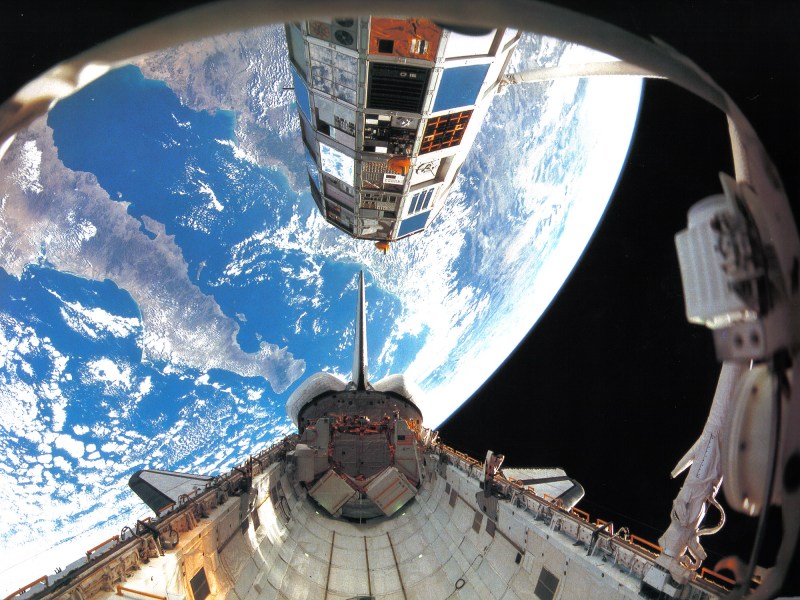
Eleven years after Skylab, the Long Duration Exposure Facility (LDEF) was launched into space for an experiment that stretched almost six years. It was considerably larger than the previous experiment, being the size of a bus.
LDEF was carried into orbit by the Space Shuttle Challenger in April 1984 with the intention of being returned to Earth in March 1985, but a series of delays meant it remained there for 5.7 years when in 1990 it was carried back by Columbia. Given the long stay, on return to Earth even the LDEF’s structure was scrutinized for any effects.
Experiments covered all twelve sides of LDEF, including the two ends. To prevent a repeat of the Skylab failure, instead of using thrusters with potentially contaminating fuel, the satellite’s attitude was controlled by having more mass at one end causing the Earth’s gravity to keep that end facing Earthward at all times.
There were 57 experiments in all from governments and universities of nine countries. Experiments included exposed materials, coatings, thermal systems, optical fibers, and electronics.
MEEP on Mir Tested Materials for Building the ISS

With the International Space Station on the drawing boards in 1996, further experiments were needed for specific materials which would be used on the station. Fortunately, the Russian Mir space station was in orbit at the time, flying at the same altitudes which the ISS would. Thus was born the Mir Environmental Effects Payload (MEEP) experiments. The experiments were carried there and retrieved back by Space Shuttles for an eighteen-month stay.
One experiment (PPMD) consisted of gold, zinc and aluminum plates. It counted how often debris hit them, the debris’ size, their source, and the damage caused. Another experiment (ODC) captured debris in aerogels for return to Earth to determine the possible origins of the debris. And the last two experiments (POSA I and POSA II) tested the effects on various materials including paint samples, glass coatings, multilayer insulation, and various metallic samples.
Experiments From The ISS Itself
In 1998, the International Space Station (ISS) started its orbital life and continues it to this day. Its purpose is to serve as a research laboratory, and being a continuously crewed, long duration station, it makes sense that it’s taken over the mantle as the primary site of space materials research.
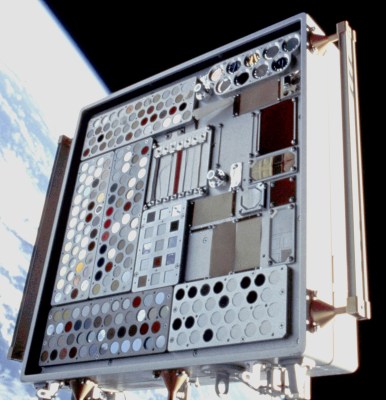
This research lives as a series of experiments designated MISSE-1 to MISSE-8, MISSE standing for Materials International Space Station Experiment. Most of the experiments are mounted on panels called Passive Experiment Containers (PECs) which, like the Skylab panels, contain the samples to be exposed to space. A few experiments are active in that they can interface with the ISS for power and communication.
To give you an idea of a typical experiment, MISSE-5 consisted of a PEC containing 36 solar cells and another PEC with more than 200 flexible materials. They’re not always PECs though. MISSE-7 included the SpaceCube, a multi-processor platform for space applications based on Xilinx Virtex 4 FX60 FPGAs whose purpose is to demonstrate radiation hardening through software.
Most MISSEs have gone up and been returned using the Space Shuttle but SpaceX has since returned some parts in its Dragon capsule.
What Has Been Learned?
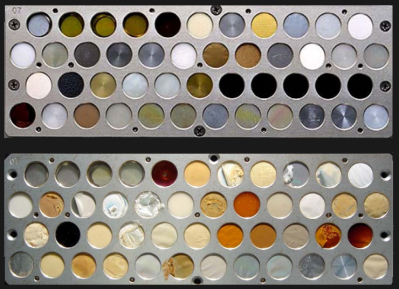
One finding of all these experiments is that the main source of material degradation in low Earth orbit (LEO) is atomic oxygen. At LEO altitudes, spacecraft move at around 27,600 km/h (17,200 mph), speeds at which collisions with atomic oxygen are energetic enough to break molecular bonds, causing oxidation. With polymers, the oxidation products are gas species, eroding materials. Some metals are also eroded. The end result is structural, thermal or optical degradation. In MISSE-1 and -2, atomic oxygen had so eroded many of the polymer samples that none remained.
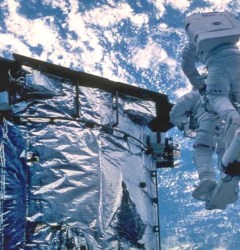
Without a significant atmosphere, radiation is another source of degradation, deteriorating and darkening many plastics and coatings. The Hubble Space Telescope gave one excellent example of radiation damage. After the Hubble had been in space for 6.8 years and during the second servicing mission by a Space Shuttle, astronauts found extensive embrittlement of some of the thermal control insulation, an aluminized-Teflon fluorinated ethylene propylene outer layer of the insulation. Testing found the cause to be electron and proton radiation, combined with solar flare x-rays and UV radiation as well as thermal effects.
Micrometeoroids and the millions of man-made debris particles can also cause damage (a meteoroid, as opposed to a meteorite, is a meteor which does not reach the Earth’s surface). Over 100 micrometeoroids impacted MISSE-1 and -2 experiments.

A non-experimental example of micrometeoroid damage was found in June 2012 when the astronauts onboard the ISS spotted the impact shown here. It appeared on one of the Cupola’s windows. The Cupola is an ISS module that’s used a lot for taking photos and video of the Earth through its seven windows. Taking a lesson from the Russian Salyut 7 space station from the 1980s, the windows have shutters and so this one’s shutter was closed while the damage was assessed and later reopened when it was deemed safe. The windows are made up of four layers: an outer debris layer, two pressure layers, and an inner scratch layer. In the event of severe damage, the windows can be replaced.
Fate Of The Tesla Roadster

That brings us to the Tesla Roadster. In case you’ve had your head buried in your latest project and haven’t heard, SpaceX recently performed the first test of their Falcon Heavy rocket with a Tesla Roadster for ballast, sending the car into an orbit around the sun and reaching as far as the asteroid belt. We reported that a recent analysis showed there’s a significant probability of it impacting the Earth or Venus in the next million years. But if it does, will it arrive in a recognizable form or as a cloud of particles?
The roadster isn’t exposed to the atomic oxygen found in Earth orbit. However, the plastic, leather seats, and rubber tires are mostly made of organic molecules containing carbon-carbon and carbon-hydrogen bonds. The energy in stellar radiation can break those bonds. Organic objects such as the carbon fiber frame which is blocked by inorganic molecules, molecules without carbon, will last longer. Any aluminum and other metals should last but the glass may eventually be shattered by meteoroids. The result, whether a decade or a million years from now, will probably be recognizable inorganic parts covered with less recognizable organic parts accompanied by a cloud of small organic particles, mostly paint chips, leaving one more materially degraded but interesting object orbiting the sun.

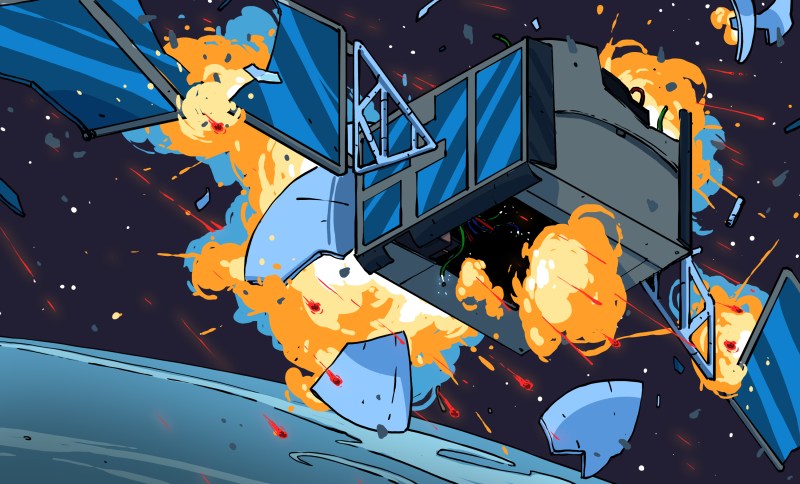














I saw an exterior photograph of MIR before it was decommissioned, and was surprised by the amount of rust on its skin.
I’d love to see these photos, if you don’t mind :)
There is no rust in orbit (or at least Iron Oxide formation) The exteriors of the modules were either painted or covered with insulating fabric blankets. Beyond degradation due to UV and atomic oxygen exposure any staining was likely caused by the hypergolic propellant used for propulsive station orientation, coolant leakage, etc
“radiation hardening through software”: Say what?
Software that is written with the assumption that the hardware is lying because of radiation hits.
Virtual Hardening, ha ha. Hey, it works in simulations right?
The good old, get the answer multiple ways and make sure they match. Also don’t assume memory remembers what you put there. If in doubt, recalculate.
It’s not just software. FPGAs are ludicrously useful for custom sensor processing for science (since you can reconfigure them) but the best FPGAs aren’t rad hard at all. So you use multiples of them, and have a simpler, rad hard system look at the results and figure out what’s correct via voting.
This is pretty common anymore. Rather than expensive rad-hardened computing hardware (which is usually very antiquated), you now just carry multiple computers and constantly have them “vote”.
“but a series of delays meant it remained there for 5.7 years” The delays being the Challenger explosion and investigation.
“What about the exposure faced by the newly launched Tesla Roadster, an entirely non-space hardened vehicle on a million-year orbit around the sun?”
I think the Tesla’s orbit is much, much, much shorter than that…
Fun fact—a million year (circular) orbit would place you approximately 10,000 AU away from the sun! For reference, the Kuiper Belt extends to about only 50 AU, and the solar system itself is only about 120 AU in radius.
They don’t mean the orbital period. They mean the duration of orbit before a suspected collision ends it’s space faring days.
Another fun fact: What you mean and what you say aren’t always aligned. “Million year orbit” does not mean the same thing as “orbiting for a million years”.
I wish I could be shot into space for a million years. Although dead it will guarantee i’ll be the last human. :-)
I wouldn’t bet on that. Walt’s head might still be around.
Where can I get a sheet of Duratin?
Do you want it in long, medium or short? Oh wait, we just ran out. :)
Thanks. Fixed.
Here you can get a roll: http://buffalous.com/solventmedia/duratin-synth-roll-up-banner.html
But normally it seems to be used for fishing hooks: https://www.ebay.ie/sch/i.html?_sop=16&_nkw=duratin
I found something about it corroding faster than steel in seawater, so a fish which ripped off a fishing line with the hook stuck in its mouth will get rid of it by corrosion.
Do anyone know whether they have experienced with magnetic dipole or electret? It would be interesting to know whether an body can form a strong enough magnetic shield so that its shielding effect would have any measurable effect on radiation or ion sourced material degradation.
Hey with the falcon heavy we could all team up and send one individual into space in an all in one satellite which would then be the reentry vehicle. They could hack and do all sorts of crazy stuff without fear of the law knocking on their door until they returned
Meth lab?
Surely you’d still have the same distribution problems unless you deliver it directly from orbit using some sort of targeted, non-terminal velocity system.
radio space anarchy i was thinking. Also set it up for enabling cheap and easy internet access over radio
“the glass may eventually be shattered by meteors”
“Meteoroids” while in space. “Meteors” after entering atmosphere. “Meteorites” after reaching the surface.
Groan (due to the multiple definitions).
So were the dinosaurs wiped out by an asterite after passing through the atmosphere as an aster after having been an asteroid in space? :) (I know, the same doesn’t apply to asteroids.)
This thread is so degrading…
B^)
heh. Don’t blame Winston.
Blame the ‘Academics’ who came up with those definitions and the other ‘Academics’ who agreed to accept them as ‘Official Nomenclature’ :)
Oh, I wasn’t blaming Winston. I was aware of meteorite vs meteoroid but not the meteor distinction, so Winston’s pointing that out was much appreciated. I’m sure even more distinctions will come out as we venture forth and begin gathering them for resources.
What about metroid?
One thing I learned working on space stuff is that the environment in low Earth orbit is actually much worse than it is in deep space, although there are some effects unique to — or at least worse in — deep space.
A few things of interest: https://www.nasa.gov/sites/default/files/files/NP-2015-03-015-JSC_Space_Environment-ISS-Mini-Book-2015-508.pdf
And
https://ntrs.nasa.gov/archive/nasa/casi.ntrs.nasa.gov/20030053331.pdf
I bet Elon wished he’d opted for the under coating.